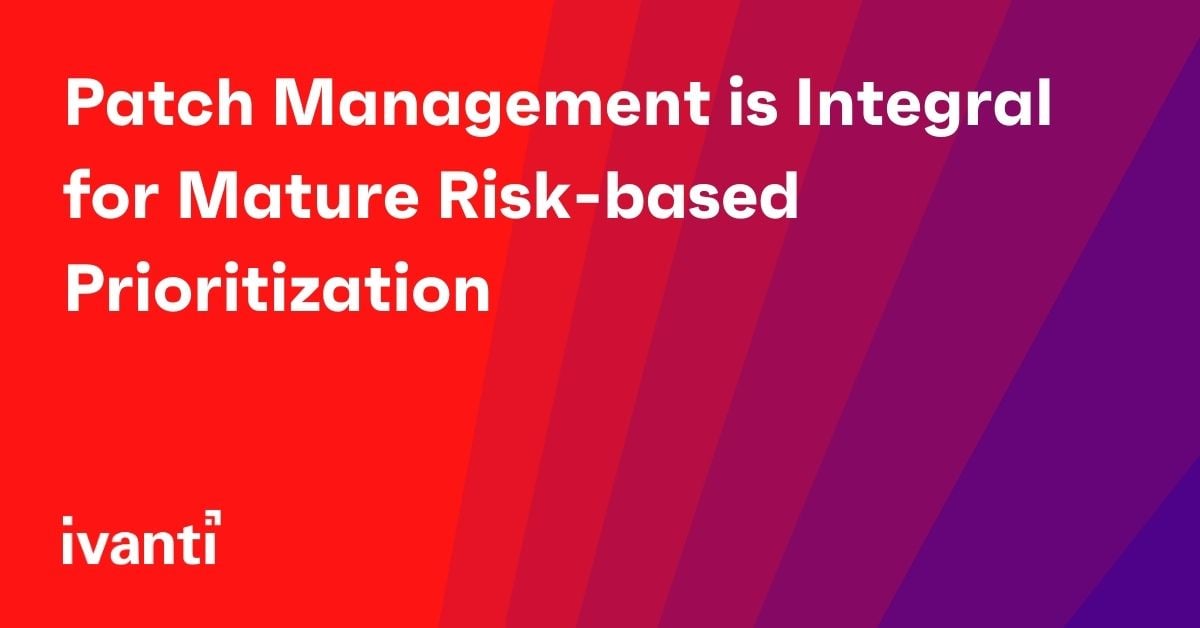Patch Management is Integral for Mature Risk-based Prioritization
Our applications and software frequently need patches as well, to fix bugs, security flaws and add feature enhancements. However, in this case, patching is not a temporary band-aid, but rather a proactive planned strategy.
Patch management is more than just repairing and updating IT software. It remediates vulnerabilities and manages risk. Patching is a subset of risk-based prioritization, and software life-cycle management. Once you identify a critical vulnerability in the operating system or applications, you must seek a resolution. It may require changing a configuration, removing an old certificate, or updating software with a patch.
Successfully reducing security risk requires extensive research and data analyses. Microsoft’s Patch Tuesday is a critical starting point and a great source for the latest information on security updates. Ivanti has put great effort and resources into providing in-depth analysis, commentary, bulletins, and tools on Patch Tuesday’s security relevance and operational impact. We cull Patch Tuesday information, along with third-party update data, and present it in a way that organizations can easily consume. Additionally, we identify the things they should be prioritizing. This enables your teams to better understand how to deal with the constant barrage of vulnerabilities and threats.
Accelerating risk prioritization requires knowing your top vulnerabilities
Effective risk management requires proper research and the assessment of extensive data. This is critical for helping organizations respond to ongoing vulnerabilities and apply risk-based prioritization. Defined policies, rationalized prioritization processes, and well-organized and analyzed data directly impact the reliability and effectiveness of how vulnerabilities are addressed.
A mature risk-based prioritization practice addresses known vulnerabilities that are rated by importance. On the day Microsoft releases updates, they include documentation that shows vulnerabilities known to be exploited in the wild. They also release other updates that are not known to be actively exploited, and those have lower priority. However, it’s important to understand how risk priorities can shift, so we can better prioritize our activities to best respond to all critical risks.
A mature risk-based prioritization approach leverages many data sources, including vulnerability trends by threat actors. It includes an automated process that feeds data sources in, analyzes and prioritizes risks, and lists activities in priority order to quickly mitigate risk.
Challenges with managing risk priority by vendor
Managing risk priority by focusing on vendor-defined severities can fall short of the mark. Risk-based prioritization takes a broad focus on risk metrics, rather than relying on a single vendor’s severity. The key is identifying, prioritizing and mitigating all critical vulnerabilities, including additional data points to classify the most critical risks to your environment. A single vendor severity simply isn’t enough.
There are many cases where the vendor’s prioritization does not reflect real world risk. Due to the nature of how vendors classify severity, a vulnerability could be classified as important, but known to be actively exploited on the day an update was released. Additional risk metrics like exploited and publicly disclosed vulnerabilities must be considered. Even telemetry on what is trending among threat actors will focus priorities to ensure the most dangerous threats are quickly resolved.
An evolutionary process
Mature risk-based prioritization encompasses an ecosystem with multiple solutions and vendors working cohesively together. An effective intelligence gathering and integration process must bridge the gap between security vulnerability assessments, threat intelligence solutions, and patch management.
Ivanti is helping to bridge this gap. We take the vulnerability assessment and other patch data, feed it into process management, prioritize vulnerabilities, and drive appropriate actions into the patch management system for rapid remediation. Ivanti Neurons for Patch Intelligence helps users easily research, prioritize, and receive better insights for best practice patch management, within one central location. We continue to expand these capabilities to create robust solutions around this evolving practice.
However, there is no panacea or silver bullet that fully automates processes and integrates everything - end-to-end. Like digital transformation, the alignment of patch management and risk-based prioritization is a layered process and an evolutionary journey.
Mature risk-based prioritization requires continuous vulnerability management. There are many challenges in overcoming the gaps between security vulnerability assessments, threat intelligence solutions, and patch management. The handoff process must take additional risk metrics into account, or crucial vulnerabilities will be overlooked.

